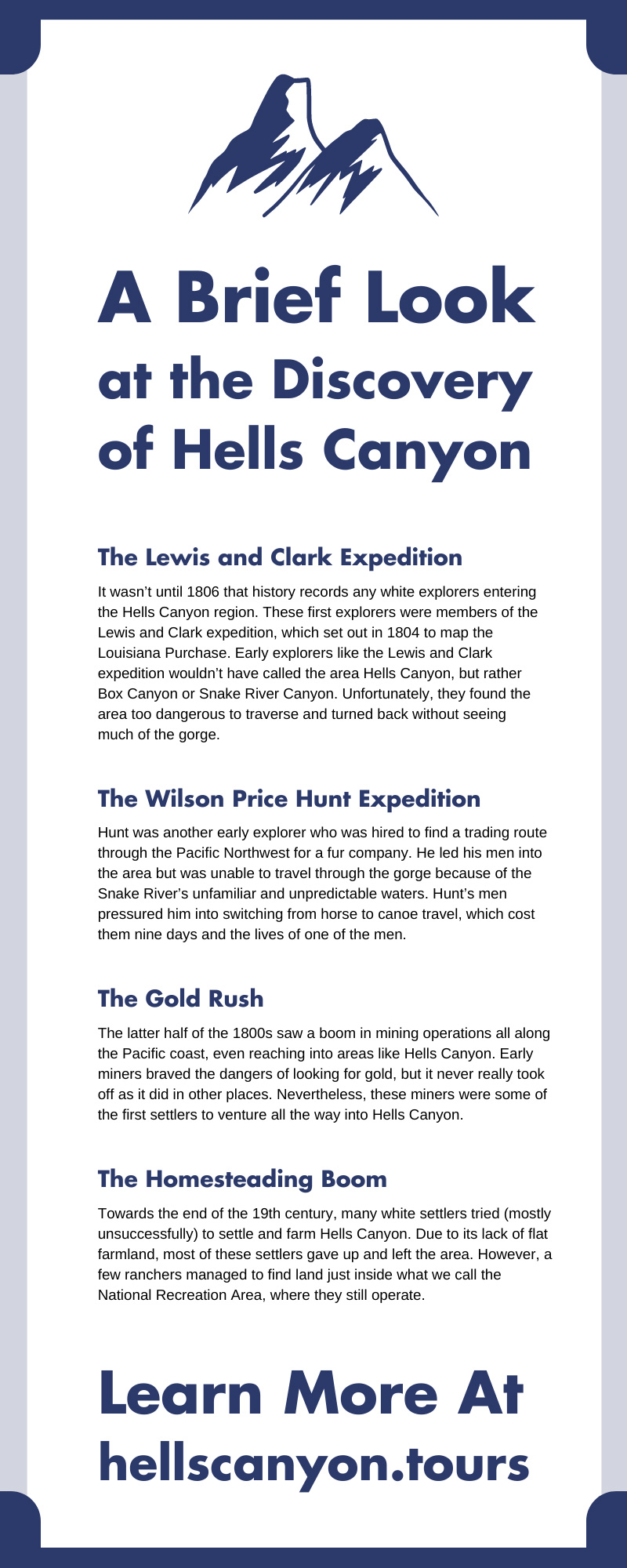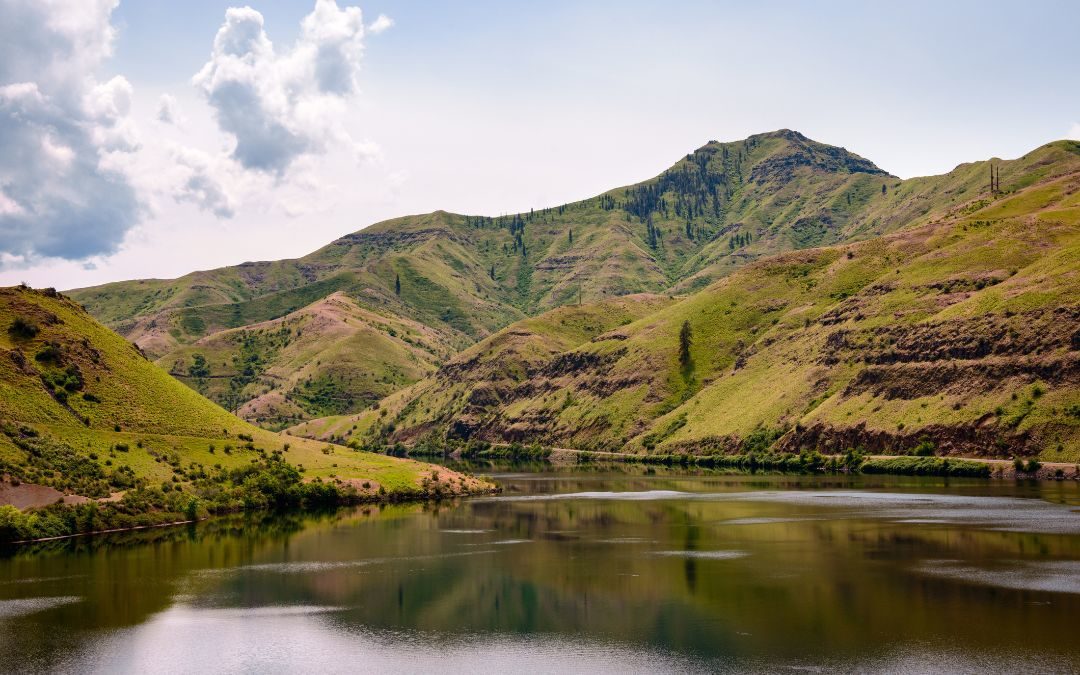If you’ve never been to Hells Canyon, you’re missing out on one of the most unique places in the entire US. You also wouldn’t be alone. For hundreds of years, colonists and explorers had a difficult time traversing the region, given its unusual terrain. Let’s take a brief look at the discovery of Hells Canyon and the indigenous people who lived there first.
The Indigenous Peoples of Hells Canyon
While white settlers may have had a hard time exploring the Hells Canyon region, the early indigenous peoples didn’t. In fact, some experts believe that the remains of one human habitation in the region could be the oldest known in North America, at a whopping 16,000 years old. The location is part of what is now called Cooper’s Ferry, though its Nez Perce name is Nipéhe.
This information may be new to some people, but the Nez Perce have long told stories about their ancestors’ presence in Hells Canyon. A long time ago, the rivers in Hells Canyon would have connected with other river networks leading up through Canada, creating a migration route. It’s very likely that the people who made their home at Nipéhe were descendants of those who traveled the long-forgotten paths of North America.
Nez Perce Petroglyphs
One of the coolest things left behind by these early inhabitants of Hells Canyon are the petroglyphs, or rock drawings, which you can still see today. These petroglyphs depict humanoid figures holding tools or instruments of some kind. While it’s unclear exactly what they represent, they’re an amazing reminder of the original inhabitants of the region.
Life in Hells Canyon
Several indigenous tribes inhabited the region known as Hells Canyon prior to its discovery by white explorers. These tribes include the Nez Perce—the earliest known residents—as well as the Shoshone-Bannock, Paiute, and Cayuse peoples. It’s likely that these indigenous tribes found the overall climate in the region very hospitable despite the terrain. Hells Canyon has milder winters than other parts of Idaho, and there were plenty of plants and animals to use as resources.
The Lewis and Clark Expedition
It wasn’t until 1806 that history records any white explorers entering the Hells Canyon region. These first explorers were members of the Lewis and Clark expedition, which set out in 1804 to map the Louisiana Purchase. Early explorers like the Lewis and Clark expedition wouldn’t have called the area Hells Canyon, but rather Box Canyon or Snake River Canyon. Unfortunately, they found the area too dangerous to traverse and turned back without seeing much of the gorge.
The Lewis-Clarke Valley
Despite the fact that the Lewis and Clark expedition didn’t get to see much of Hells Canyon, they still got the valley that begins the Hells Canyon river gorge named after them, the Lewis-Clark Valley. When you visit the valley, you get to experience the same breath-taking views as the expedition did. However, what’s even better is that you can actually explore the region!
The Wilson Price Hunt Expedition
Hunt was another early explorer who was hired to find a trading route through the Pacific Northwest for a fur company. He led his men into the area but was unable to travel through the gorge because of the Snake River’s unfamiliar and unpredictable waters. Hunt’s men pressured him into switching from horse to canoe travel, which cost them nine days and the lives of one of the men.
Why Was Traveling Through Hells Canyon Difficult?
As we already mentioned, many of the explorers who came to Hells Canyon had a hard time navigating it. However, we also know that indigenous people thrived in the area for many years. What made it so hard for explorers to traverse?
Well, one explanation is the way that 19th-century exploration parties operated. They had lots of people, animals, and supplies to bring with them through the wilderness. Like a military convoy, they were only as fast as their slowest animal or vehicle, and they performed best in open, flat land. Hells Canyon is anything but flat. It must have been a nightmare trying to move all that equipment through a deep river gorge.
Another issue was the Snake River. Imagine trying to move horses, crates of supplies, and dozens of men across a fast-flowing river. Without modern vehicles, river crossings like this one could be far more dangerous than encountering wild animals. It’s no wonder these early explorers had so much trouble.
The Gold Rush
The latter half of the 1800s saw a boom in mining operations all along the Pacific coast, even reaching into areas like Hells Canyon. Early miners braved the dangers of looking for gold, but it never really took off as it did in other places. Nevertheless, these miners were some of the first settlers to venture all the way into Hells Canyon.
Unfortunately, one of the most tragic events in Hells Canyon occurred during this time period. It was the Hells Canyon Massacre, where a horse gang of white mercenaries robbed and murdered several dozen Chinese miners. While most of the men responsible were found and tried, none of them were successfully convicted.
The Homesteading Boom
Towards the end of the 19th century, many white settlers tried (mostly unsuccessfully) to settle and farm Hells Canyon. Due to its lack of flat farmland, most of these settlers gave up and left the area. However, a few ranchers managed to find land just inside what we call the National Recreation Area, where they still operate.
Discovery Over Time
The discovery of Hells Canyon didn’t happen overnight. It began with indigenous tribes moving into the area thousands of years ago, followed by white settlers during the 19th century. Across all that time, Hells Canyon has continued to fascinate people from all cultures with its natural majesty and unique plant and animal life. Its rivers are home to legendary sturgeon and salmon populations, and its rock formations seem like they come from another world.
You can experience the beauty of Hells Canyon and the Snake River for yourself with a Hells Canyon boat tour from River Adventures. We use state-of-the-art jet boats to zip up and down the river, giving you the chance to see more of Hells Canyon in one day than Lewis and Clark ever saw in one lifetime. We even provide lunch, and our guides will tell you all about the plants, animals, and places that you see. Let us know today if you’re interested in joining us!


Recent Comments